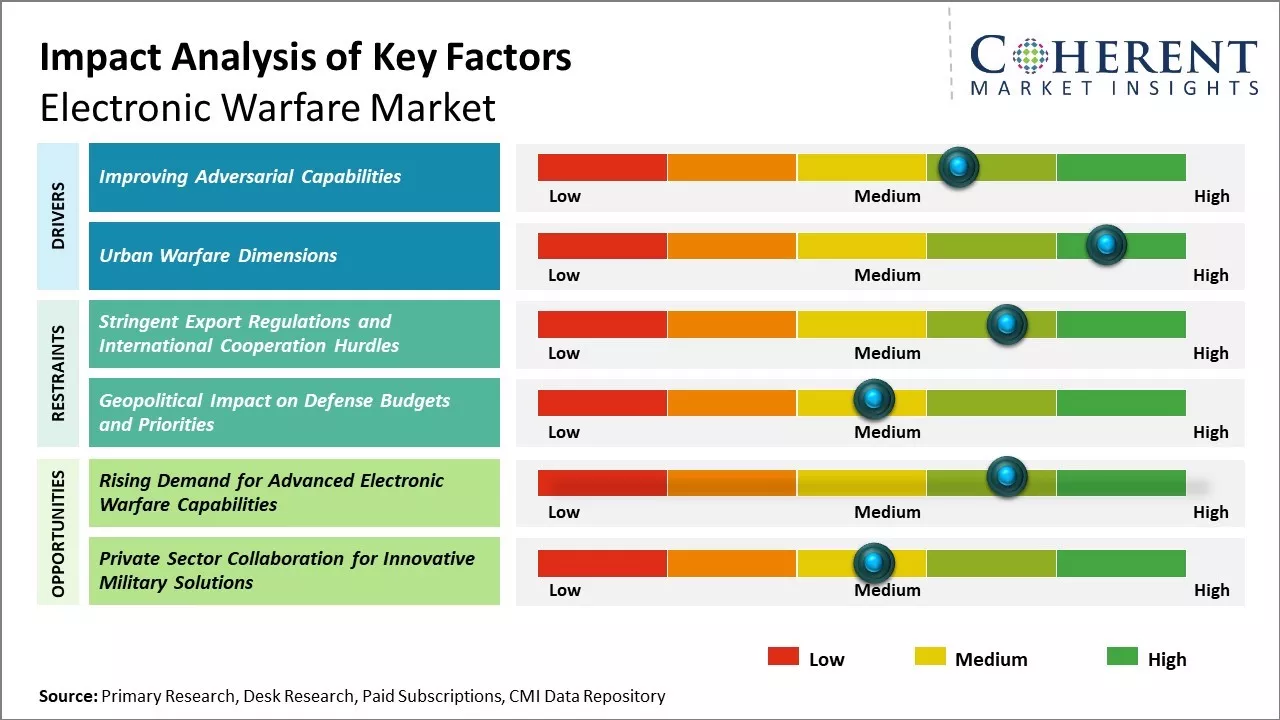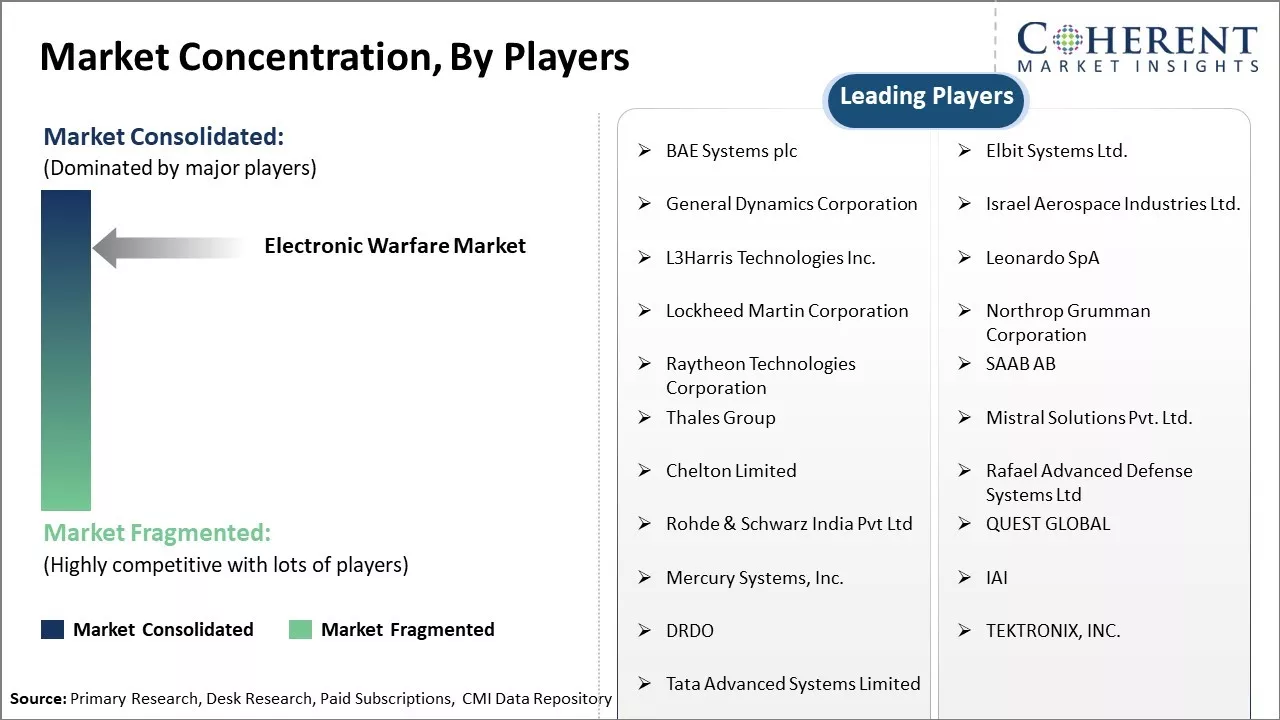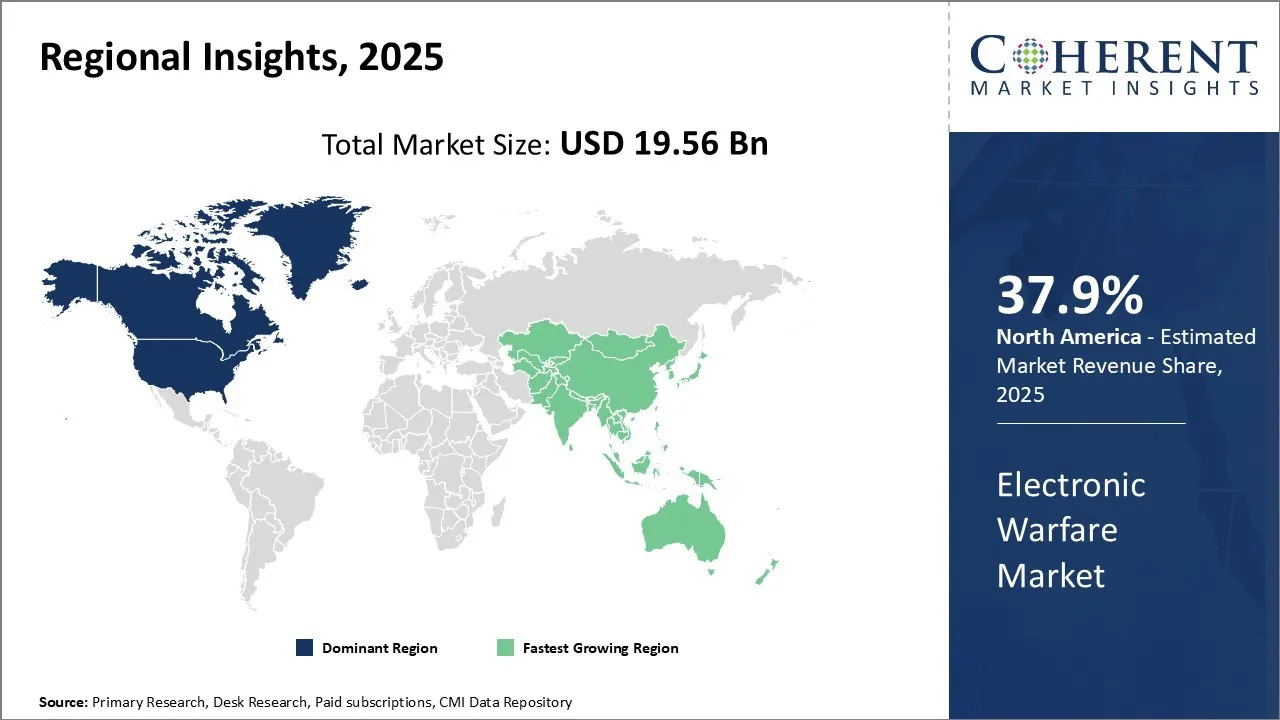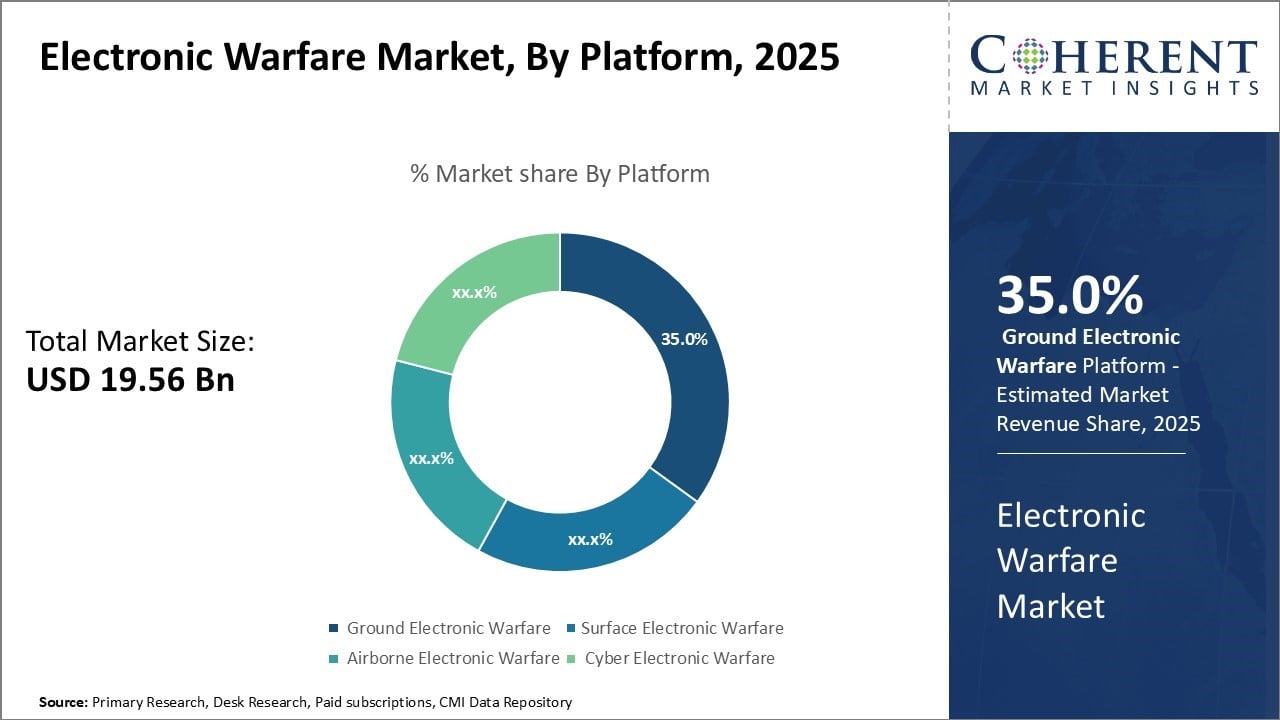Electronic Warfare Market Size And Share Analysis - Growth Trends And Forecasts (2025-2032)
The electronic warfare market is estimated to be valued at USD 19.56 Bn in 2025 and is expected to reach USD 29.43 Bn by 2032, growing at a compound annual growth rate (CAGR) of 6.0% from 2025 to 2032.

To learn more about this report, Download Free Sample
Key Takeaways
- By Platform, the Ground Electronic Warfare is projected to dominate the global electronic warfare market with a significant 35.0% share in 2025. This dominance is attributed to heightened global defence spending on land-based military systems.
- By Capability, the Electronic Protection is anticipated to lead the capability segment with a commanding 31.62% share in 2025. This growth is primarily driven by the escalating complexity of threats from advanced missiles, radar systems, and electromagnetic attacks.
- North America is projected to maintain its leadership position in the global electronic warfare market, accounting for a 37.9% market share in 2025.
- Asia Pacific has emerged as the fastest-growing region in the electronic warfare market, exhibiting a robust CAGR of 7.65%.
Market Overview
The global Electronic Warfare Market is witnessing robust growth, fuelled by rising geopolitical tensions, increased defence budgets, and the modernization of military systems. Demand for advanced electronic protection, attack, and support capabilities is driving investments in EW technologies across land, air, and naval platforms. Ground-based systems lead the platform segment, while electronic protection remains the dominant capability. North America continues to lead the market, backed by strong defence infrastructure and leading defence contractors. Asia Pacific is emerging as the fastest-growing region with strategic defence upgrades.
Current Events and its Impact on the Electronic Warfare Market
|
Current Event |
Description and its impact |
|
Technology Commercialization and Product Launches |
|
|
Strategic Investments and Collaborations |
|
|
Technology Commercialization and Product Launches |
|
Uncover macros and micros vetted on 75+ parameters: Get instant access to report
Pricing Analysis – Electronic Warfare Market
The pricing landscape in the electronic warfare (EW) market is influenced by system complexity, platform integration, and technological advancement. High-end EW systems integrated into fighter jets, naval vessels, and ground platforms can range from $5 million to over $50 million per unit, depending on capabilities such as jamming, signal intelligence, and electronic protection. Airborne and naval EW systems typically command higher prices due to advanced hardware, multi-spectrum coverage, and software-defined capabilities.
Modular and portable ground-based EW systems, while more affordable, still range between $500,000 to $5 million, depending on their scalability and mission roles. Pricing also reflects regional manufacturing costs, regulatory compliance, and R&D expenditures. Defence contractors often offer customized pricing based on military specifications, export controls, and long-term support agreements.
With increasing demand for AI-driven, autonomous EW solutions, pricing is expected to rise moderately, especially in regions investing in modern, network-centric warfare capabilities.
Role of Emerging Technologies – Electronic Warfare Market
Emerging technologies are transforming the electronic warfare (EW) market by enabling faster, smarter, and more adaptive defence systems. Artificial Intelligence (AI) and machine learning are playing a critical role in real-time threat detection, automated decision-making, and dynamic signal processing, allowing EW systems to respond instantly to evolving threats. Software-defined radios (SDRs) are enhancing flexibility, enabling rapid reconfiguration of EW capabilities across multiple frequency bands.
Cyber-electronic integration is another key trend, combining cyber defence with EW to protect against both physical and digital attacks. Additionally, quantum sensing and advanced microelectronics are improving signal accuracy and reducing latency in detection and jamming operations.
Miniaturization is enabling the deployment of EW systems on smaller platforms like UAVs and satellites, expanding operational reach. These innovations are reshaping modern military strategies by offering enhanced survivability, interoperability, and adaptability in increasingly contested and complex electromagnetic environments.
Market Concentration and Competitive Landscape

To learn more about this report, Download Free Sample
Electronic Warfare Market Trends
- Improving Adversarial Capabilities
With evolving geo-political tensions and increasingly sophisticated technologies being developed by various nation states, maintaining military supremacy is becoming all the more critical. While advanced nations have historically held an edge in electronic warfare capabilities, the gap seems to be narrowing at a far quicker pace than before.
Countries across Asia and the Middle East that were traditionally not considered strong military powers are making heavy investments in this domain to bolster their defence systems. They are procuring latest generation jammers, intelligence gathering systems as well as offensive cyber weapons to enhance their strategic and tactical abilities. Further, state actors are also relying on covert hacking groups and private military contractors to intensify hybrid warfare techniques.
In March 2022, BAE Systems which is a multinational arms, security and aerospace company, announced the introduction of a new electronic warfare (EW) suite called Storm EW Modules. This technology provides both offensive and defensive capabilities and is designed to be adaptable for use across the U.S. and allied fleets. It can be integrated into guided missiles, unmanned aerial vehicles, fixed-wing aircraft, and helicopters.
In July 2025, The Times of India reported that India deployed high-frequency GPS jammers along the Pakistan border following the Pahalgam attack as part of an electronic warfare initiative. Systems like Samyukta, Himshakti, SPECTRA, and KALI-5000 were used to disrupt Pakistan’s satellite navigation and targeting systems, reflecting a strategic shift toward electromagnetic dominance.
- Urban Warfare Dimensions
While inter-state conflicts have largely reduced post world war era, incidence of low intensity warfare within densely populated areas seem to be on the rise. Various militant and terrorist networks are now increasingly relying on urban centres to plot attacks as well as shield their activities.
Such asymmetric belligerents exploit civilian infrastructure like telecommunication towers, internet servers as well as commercial satellite systems for coordination and information dissemination purposes. At the same time, collateral damage concerns seriously hamper the deployment of traditional weaponry against them.
Over the last decade, warfare in dense metropolitan areas like Iraq, Afghanistan, Syria, and Yemen have highlighted the need for specialized equipment that can effectively map, detect, and neutralize such agile enemies without significant environmental damage.
Technologies like non-line-of-sight communications, compact jamming solutions, Radio Frequency sensors integrated on unmanned vehicles, and precision directed energy weapons are being developed to gain intelligence and conduct targeted strikes in urban combat environments.
In May 2025, The Times of India reported that the Indian Army conducted trials of next-generation indigenous defence systems under simulated combat, showcasing a suite of integrated electronic warfare (EW) platforms—including counter‑UAS solutions, EW jammers, and radars during exercises at Pokhran, Babina, and Joshimath as part of its “Decade of Transformation.”
Opportunities In the Electronic Warfare Market
- Rising Demand for Advanced Electronic Warfare Capabilities
Despite challenges, opportunities exist to grow the electronic warfare market. As modern conflicts become more sophisticated, demand will rise for advanced capabilities like electronic attack and protection.
Nations are allocating greater resources to cyber and EW defences. There are also chances for private companies to partner with militaries to develop innovative solutions using new materials and artificial Intelligence.
Global Electronic Warfare Market Insights, By Platform
The ground electronic warfare segment is projected to dominate the global electronic warfare market with a substantial 35.0% share in 2025. This dominance stems from the increasing defence expenditure on land-based systems and the growing need to counter emerging threats in ground combat zones. Armed forces globally are integrating sophisticated jamming, interception, and signal disruption tools into tanks, armoured personnel carriers, and mobile command units.
Ground-based EW systems provide tactical advantages during battlefield engagements, particularly in electronic signal disruption and threat detection. With the growing adoption of Cognitive Electronic Warfare basics, these systems are becoming more adaptive and intelligent, leveraging real-time learning and decision-making to counter complex and evolving threats.
As militaries emphasize modernization of land forces and border security enhancements, ground electronic warfare platforms now empowered by cognitive capabilities are expected to maintain their leadership position across global defence strategies.
Global Electronic Warfare Market Insights, By Capability
Electronic protection is anticipated to lead the capability segment with a commanding 31.62% share in 2025. This growth is driven by the increasing sophistication of electronic threats, including advanced missile guidance systems, radar detection, and cyber-electromagnetic attacks. As adversaries adopt more complex and agile electronic warfare tactics, defence agencies are prioritizing protection mechanisms to safeguard critical assets.
Electronic protection systems are designed to detect, jam, and neutralize hostile signals, ensuring the integrity of friendly communications and navigation systems. Their critical role in multi-domain operations spanning land, air, and naval theatres cements their importance in strategic defence planning, making them a focal point of modern EW development.
Global Electronic Warfare Market – Regional Insights

To learn more about this report, Download Free Sample
North America Electronic Warfare Market Trends and Analysis
North America is projected to maintain its leadership position in the global electronic warfare market, accounting for an estimated 37.9% market share in 2025. This dominance is driven by the United States’ massive defence expenditure, which fuels continuous investments in state-of-the-art EW technologies across land, air, naval, and space domains.
The region is home to global defence giants such as Lockheed Martin, Raytheon Technologies, and Northrop Grumman, which lead advancements in jamming systems, signal intelligence, and electronic countermeasures.
Ongoing modernization efforts, such as the U.S. Department of Defence’s EW capability upgrades and Canada’s defence renewal programs, are further strengthening North America’s position in the market. Additionally, increased focus on multi-domain operations and spectrum superiority is shaping future EW strategies.
With sustained government support, a robust R&D ecosystem, and strong defence-industrial partnerships, North America continues to serve as a global hub for electronic warfare innovation and deployment.
Asia Pacific Electronic Warfare Market Trends and Analysis
Asia Pacific has emerged as the fastest-growing region in the global electronic warfare market, demonstrating a compelling CAGR of 7.65%. This growth is primarily fuelled by escalating regional security concerns and increasing defence budgets in key countries such as China, India, Japan, and South Korea. With rising geopolitical tensions and border disputes, national defence forces are prioritizing the development and acquisition of sophisticated EW capabilities.
Governments in the region are making strategic investments in radar jamming, signal intelligence, and cyber-electronic systems, aiming to reduce dependency on foreign suppliers and strengthen indigenous defence production. Collaborations between regional players and global defence firms are fostering the co-development of advanced EW technologies. As Asia Pacific nations accelerate military modernization and focus on self-reliance, the region is positioned as a key driver of future growth in the global electronic warfare landscape.
Electronic Warfare Market Dominating Countries
United States and Canada
The United States is the undisputed leader in the global electronic warfare market, bolstered by its massive defence budget and commitment to maintaining electromagnetic spectrum superiority. The country’s strategic focus on multi-domain operations—across air, land, sea, and space—has resulted in continuous investments in cutting-edge EW technologies.
Key defence contractors such as Lockheed Martin, Raytheon Technologies, and Northrop Grumman spearhead innovations in jamming systems, radar countermeasures, signal intelligence, and autonomous EW platforms. Major modernization programs by the U.S. Department of defence, including the development of AI-integrated and modular EW systems, ensure the nation’s technological and operational dominance.
Canada complements U.S. advancements through its own defence renewal efforts and growing investments in electronic warfare capabilities. The country is actively upgrading its naval and air defence platforms with EW suites to improve detection, protection, and resilience against emerging threats.
With increasing emphasis on joint operations with allied forces and participation in NATO-led electronic warfare exercises, Canada is reinforcing its strategic role in North America's EW ecosystem. Combined, the U.S. and Canada serve as a powerful force driving innovation, interoperability, and global leadership in electronic warfare.
Market Report Scope
Electronic Warfare Market Report Coverage
| Report Coverage | Details | ||
|---|---|---|---|
| Base Year: | 2024 | Market Size in 2025: | USD 19.56 Bn |
| Historical Data for: | 2020 To 2024 | Forecast Period: | 2025 To 2032 |
| Forecast Period 2025 to 2032 CAGR: | 6.0% | 2032 Value Projection: | USD 29.43 Bn |
| Geographies covered: |
|
||
| Segments covered: |
|
||
| Companies covered: |
BAE Systems plc, Elbit Systems Ltd., General Dynamics Corporation, Israel Aerospace Industries Ltd., L3Harris Technologies Inc., Leonardo SpA, Lockheed Martin Corporation, Northrop Grumman Corporation, Raytheon Technologies Corporation, SAAB AB, Thales Group, Mistral Solutions Pvt. Ltd., Chelton Limited, Rafael Advanced Defense Systems Ltd, Rohde & Schwarz India Pvt Ltd, QUEST GLOBAL, Mercury Systems, Inc., IAI, DRDO, TEKTRONIX, INC., and Tata Advanced Systems Limited |
||
| Growth Drivers: |
|
||
| Restraints & Challenges: |
|
||
Uncover macros and micros vetted on 75+ parameters: Get instant access to report
Analyst Viewpoint – Electronic Warfare Market
- The global electronic warfare (EW) market, driven by escalating geopolitical tensions, rising defence expenditures, and the growing need for multi-domain operational superiority. As modern warfare increasingly relies on electromagnetic spectrum control, EW systems are becoming indispensable across land, air, sea, and space domains.
- Experts highlight electronic protection as the leading capability segment due to its critical role in countering advanced missile systems, radar threats, and electronic attacks. Ground-based EW platforms remain dominant, supported by continued investments in mobile jamming units, tactical signal intelligence systems, and border surveillance operations.
- North America continues to lead the global EW market, underpinned by the U.S.’s vast defence budget, strong industrial base, and ongoing modernization programs. Asia Pacific is emerging as the fastest-growing region, with countries like China and India accelerating indigenous EW development and technology partnerships.
- Looking ahead, analysts believe that the integration of AI, cyber-electronic convergence, and space-based EW capabilities will be critical in reshaping Future of Electronic Warfare technology. Strategic collaborations among defence contractors, governments, and R&D institutions are expected to drive innovation and enhance spectrum dominance in increasingly complex threat environments.
Electronic Warfare Market: Key Development
- In May 2025, the RAF introduced StormShroud, a Tekever AR3 unmanned aircraft fitted with a BriteCloud jammer for preflight suppression of enemy air defenses. This deployment marks a shift toward unmanned wingman strategies, increasing force protection via low-cost, reusable drone-based stand-in jamming.
- In January 2025, the U.S. Air Force delivered the first two F‑15E Strike Eagles equipped with the Eagle Passive/Active Warning and Survivability System (EPAWSS) to the RAF Lakenheath base in the UK. This milestone enhances threat detection and electronic countermeasures for allied forces, significantly elevating aircrew survivability in contested zones and reinforcing interoperability among NATO partners.
- In January , 2025, the new L3Harris Viper Shield EW suite completed its first flight aboard a Block 70 F‑16 at Edwards AFB. The integration advances F‑16 electronic defence capabilities, offering enhanced jamming and situational awareness. This modernization supports Middle Eastern operators like Bahrain and symbolizes rising export potential.
- In May 2024, At SOF Week in May 2024, Anduril Industries introduced Pulsar, a compact AI-powered EW system to detect and counter emerging threats, particularly hostile drones. Analysts view Pulsar as a game-changer, demonstrating how AI integration enables rapid threat recognition and scalable, adaptive EW capabilities across diverse operational environments.
- In April 2024, BAE Systems released its AI-based cognitive electronic warfare platform, designed to autonomously identify and counter dynamic electronic threats. This launch reinforces the trend toward AI-enabled EW, improving responsiveness and reducing operator burden driving modernization across legacy and new military platforms.
Market Segmentation
- By Platform
- Surface Electronic Warfare
- Ground Electronic Warfare
- Airborne Electronic Warfare
- Cyber Electronic Warfare
- By Capability
- Electronic Attack
- Electronic Protection
- Electronic Support
- Mission Support
- By Regional
- North America
- U.S.
- Canada
- Europe
- U.K.
- Germany
- Italy
- France
- Spain
- Russia
- Rest of Europe
- Asia Pacific
- China
- India
- Japan
- ASEAN
- Australia
- South Korea
- Rest of Asia Pacific
- Latin America
- Brazil
- Argentina
- Rest of Latin America
- Middle East
- GCC
- Israel
- Rest of Middle East
- Africa
- Northern Africa
- Central Africa
- South Africa
- North America
- Key Players Insights
- BAE Systems plc
- Elbit Systems Ltd.
- General Dynamics Corporation
- Israel Aerospace Industries Ltd.
- L3Harris Technologies Inc.
- Leonardo SpA
- Lockheed Martin Corporation
- Northrop Grumman Corporation
- Raytheon Technologies Corporation
- SAAB AB
- Thales Group
- Mistral Solutions Pvt. Ltd.
- Chelton Limited
- Rafael Advanced Defense Systems Ltd.
- Rohde & Schwarz India Pvt Ltd.
- QUEST GLOBAL
- Mercury Systems, Inc.
- IAI
- DRDO
- TEKTRONIX, INC.
- Tata Advanced Systems Limited
Sources
The Stakeholders Consulted
- Senior defense procurement officers and military program planners
- Electronic warfare system integrators and defense OEMs
- Military communication and signal intelligence experts
- Government defense ministries and R&D laboratories
- Aerospace and defense platform manufacturers
- Cybersecurity and electromagnetic spectrum management advisors
- Defense technology consultants and battlefield systems engineers
- End-users across air force, navy, ground forces, and joint operations commands
Databases Opened
- U.S. Department of Defense – Budget and Acquisition Reports
- NATO Allied Command Transformation – EW Capability Briefs
- SIPRI (Stockholm International Peace Research Institute) – Military Expenditure Database
- Indian Ministry of Defence – Annual Defence Reports
- European Defence Agency – Capability Development Plans
- World Bank – Defense & Security Sector Public Spending
Magazines & Trade Publications
- Military & Aerospace Electronics Magazine
- Defence Technology Review
- Signal Magazine – AFCEA International
- Armada International – EW & C4ISR Coverage
- Airforce Technology – EW System Features
- Electronic Design – Defense and RF Systems Section
Scientific and Industry Journals
- Journal of Electronic Defense (JED)
- IEEE Transactions on Aerospace and Electronic Systems
- Defence Science Journal (DRDO)
- International Journal of Microwave and Wireless Technologies
- Journal of Electromagnetic Waves and Applications
- IEEE Transactions on Electromagnetic Compatibility
Newspapers & Media Outlets
- Defense News – Electronic Warfare & C4ISR Section
- Janes – EW and Signal Intelligence Reports
- Reuters – Global Defense Sector Updates
- Bloomberg Government – U.S. Defense Technology Trends
- The Economic Times – Defence and Aerospace Section
- Business Standard – Indian Defence Procurement and Modernization
Associations and Regulatory Bodies
- U.S. Department of Defense (DoD)
- NATO Communications and Information Agency (NCIA)
- Defence Research and Development Organisation (DRDO), India
- European Defence Agency (EDA)
- Association of Old Crows (AOC) – Global EW Community
- Ministry of Defence (MOD), UK
- Centre for Air Power Studies (CAPS), India
Public Domain Sources
- Congressional Research Service (CRS) – U.S. Defense Reports
- European Commission – Defense and Security Programs
- UN Register of Conventional Arms – Global Military Tech Trade
- Government Accountability Office (GAO) – EW Program Audits
- Indian Defence Budget Documents and PIB Press Releases
- NATO Open Source Intelligence – EW Capabilities Overview
Proprietary Research Elements
- CMI Expert Interviews and Transcripts (focused on EW platform development, integration challenges, and future capabilities)
- CMI Defense Systems Tracker – EW System Pipeline Analysis
- CMI Repository of Global EW Contracts and Tender Documents (past 10 years)
- CMI Analytics Tool – Forecast Modeling and Regional EW Spend Estimation
Share
Share
About Author
Suraj Bhanudas Jagtap is a seasoned Senior Management Consultant with over 7 years of experience. He has served Fortune 500 companies and startups, helping clients with cross broader expansion and market entry access strategies. He has played significant role in offering strategic viewpoints and actionable insights for various client’s projects including demand analysis, and competitive analysis, identifying right channel partner among others.
Missing comfort of reading report in your local language? Find your preferred language :
Transform your Strategy with Exclusive Trending Reports :
Frequently Asked Questions
EXISTING CLIENTELE
Joining thousands of companies around the world committed to making the Excellent Business Solutions.
View All Our Clients

